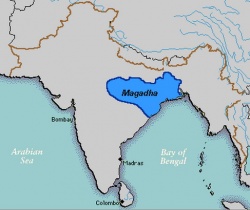Difference between revisions of "Magadha"
(Created page with "thumb|250px| Magadha (Sanskrit: मगध) formed one of the sixteen Mahā-Janapadas (Sanskrit: "Great Countries") or kingdoms in ancient [[India]...") |
|||
| (10 intermediate revisions by 2 users not shown) | |||
| Line 1: | Line 1: | ||
[[File:Magadha_map.JPG|thumb|250px|]] | [[File:Magadha_map.JPG|thumb|250px|]] | ||
| − | |||
| − | The earliest reference to the [[Magadha]] people occurs in the | + | |
| + | |||
| + | |||
| + | [[Magadha]] ([[Sanskrit]]: मगध) formed one of the sixteen [[Mahā-Janapadas]] ([[Sanskrit]]: "[[Great Countries]]") or {{Wiki|kingdoms}} in {{Wiki|ancient}} [[India]]. | ||
| + | |||
| + | |||
| + | [[Magadha]] (S): One of the four great {{Wiki|kingdoms}} (i.e. | ||
| + | |||
| + | [[Magadha]], | ||
| + | |||
| + | [[Kosala]], | ||
| + | |||
| + | [[Vansa]], and | ||
| + | |||
| + | [[Avanti]]) in {{Wiki|ancient India}}, ruled from its capital[[ Rajagaha]]. The [[king]] of [[Magadha]], [[Bimbisara]], became a follower of [[Shakyamuni]]. | ||
| + | |||
| + | |||
| + | The core of the {{Wiki|kingdom}} was the area of [[Bihar]] {{Wiki|south}} of the [[Ganges]]; its first {{Wiki|capital}} was [[Rajagriha]] ({{Wiki|modern}} [[Rajgir]]) then {{Wiki|Pataliputra}} ({{Wiki|modern}} [[Patna]]). | ||
| + | |||
| + | [[Magadha]] expanded to include most of {{Wiki|Bihar}} and {{Wiki|Bengal}} with the conquest of {{Wiki|Licchavi}} and [[Anga]] respectively, followed by much of eastern {{Wiki|Uttar Pradesh}} and {{Wiki|Orissa}}. | ||
| + | |||
| + | The {{Wiki|ancient}} {{Wiki|kingdom}} of [[Magadha]] is heavily mentioned in [[Jain]] and [[Buddhist]] texts. It is also mentioned in the {{Wiki|Ramayana}}, {{Wiki|Mahabharata}}, {{Wiki|Puranas}}. | ||
| + | |||
| + | The earliest reference to the [[Magadha]] [[people]] occurs in the {{Wiki|Atharva-Veda}} where they are found listed along with the [[Angas]], [[Gandharis]], and [[Mujavats]]. | ||
| + | |||
| + | Two of [[India's]] major [[religions]], [[Jainism]], and [[Buddhism]] have [[roots]] in [[Magadha]]; two of [[India's]] greatest empires, the {{Wiki|Maurya Empire}} and {{Wiki|Gupta Empire}}, originated from [[Magadha]]. | ||
| + | |||
| + | These empires saw advancements in {{Wiki|ancient}} [[India]]'s [[science]], {{Wiki|mathematics}}, [[astronomy]], [[religion]], and [[philosophy]] and were considered the [[Indian]] "Golden Age". The [[Magadha]] {{Wiki|kingdom}} included republican communities such as the {{Wiki|community}} of Rajakumara. | ||
| + | |||
| + | Villages had their [[own]] assemblies under their local chiefs called Gramakas. Their administrations were divided into executive, judicial, and {{Wiki|military}} {{Wiki|functions}}. | ||
| + | |||
| + | |||
{{W}} | {{W}} | ||
[[Category:Buddhism]] | [[Category:Buddhism]] | ||
[[Category:India]] | [[Category:India]] | ||
Latest revision as of 20:19, 24 August 2016
Magadha (Sanskrit: मगध) formed one of the sixteen Mahā-Janapadas (Sanskrit: "Great Countries") or kingdoms in ancient India.
Magadha (S): One of the four great kingdoms (i.e.
Vansa, and
Avanti) in ancient India, ruled from its capitalRajagaha. The king of Magadha, Bimbisara, became a follower of Shakyamuni.
The core of the kingdom was the area of Bihar south of the Ganges; its first capital was Rajagriha (modern Rajgir) then Pataliputra (modern Patna).
Magadha expanded to include most of Bihar and Bengal with the conquest of Licchavi and Anga respectively, followed by much of eastern Uttar Pradesh and Orissa.
The ancient kingdom of Magadha is heavily mentioned in Jain and Buddhist texts. It is also mentioned in the Ramayana, Mahabharata, Puranas.
The earliest reference to the Magadha people occurs in the Atharva-Veda where they are found listed along with the Angas, Gandharis, and Mujavats.
Two of India's major religions, Jainism, and Buddhism have roots in Magadha; two of India's greatest empires, the Maurya Empire and Gupta Empire, originated from Magadha.
These empires saw advancements in ancient India's science, mathematics, astronomy, religion, and philosophy and were considered the Indian "Golden Age". The Magadha kingdom included republican communities such as the community of Rajakumara.
Villages had their own assemblies under their local chiefs called Gramakas. Their administrations were divided into executive, judicial, and military functions.
